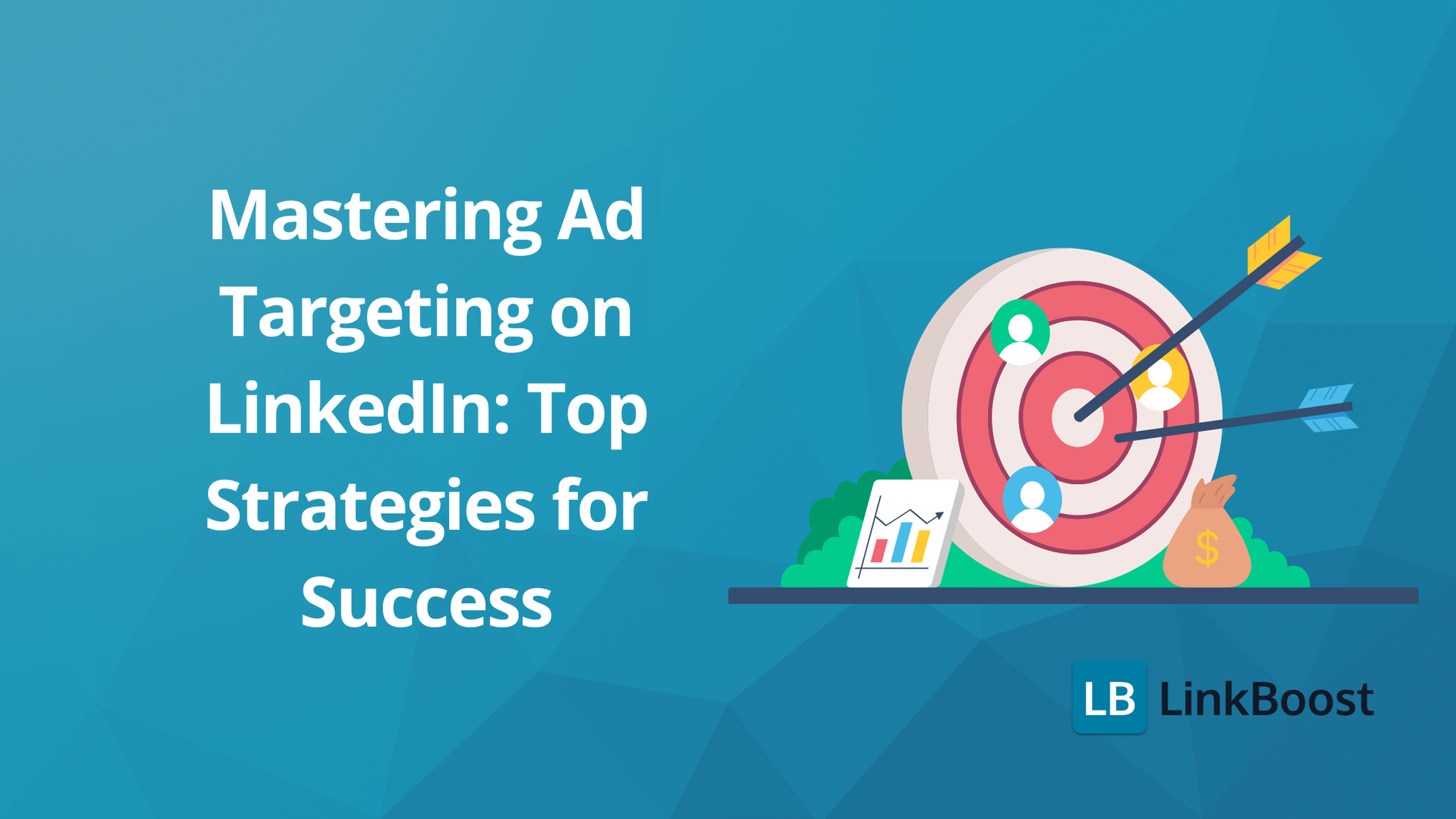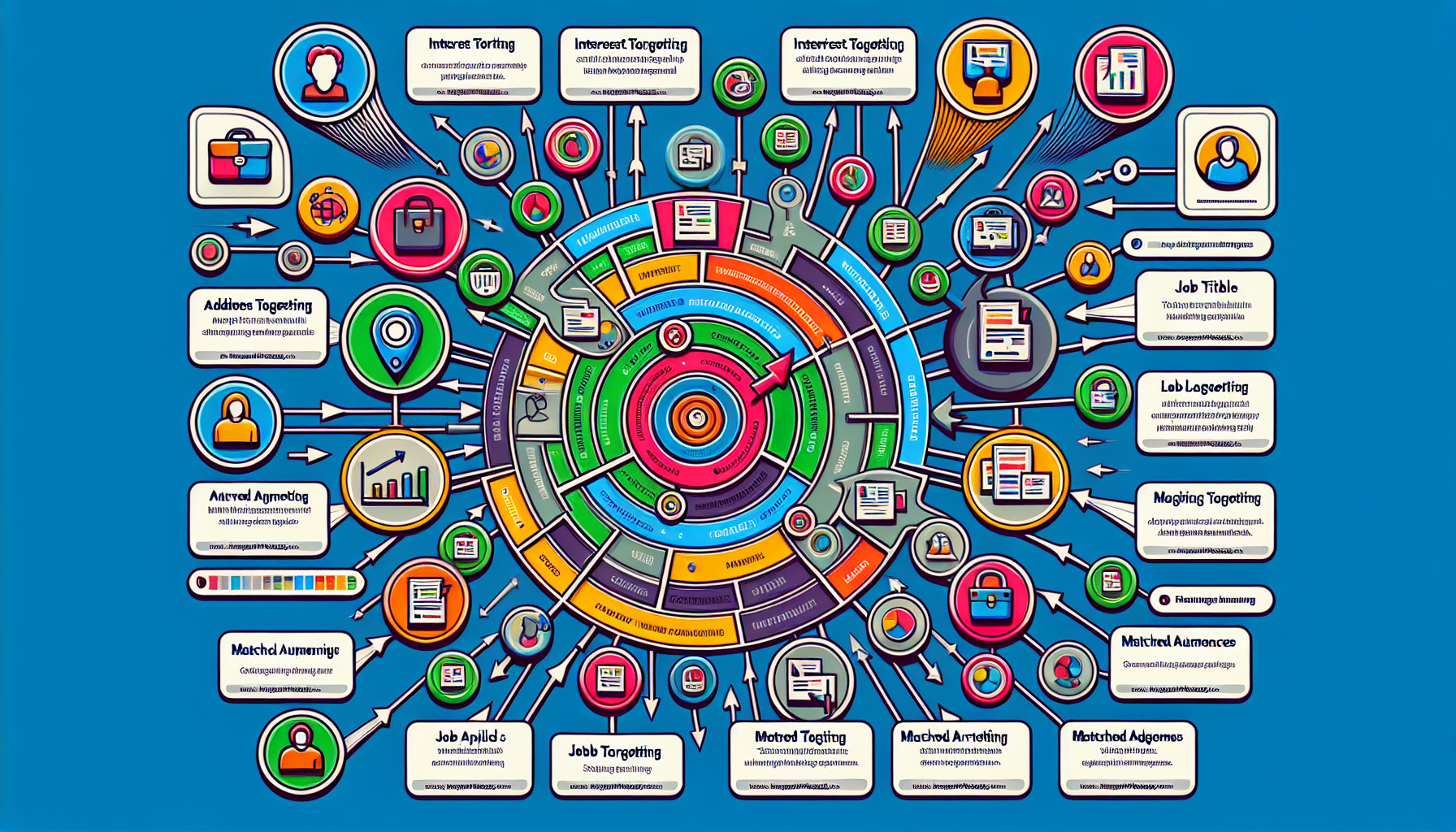Mastering Ad Targeting on LinkedIn: Top Strategies for Success

Targeting on LinkedIn is essential for reaching the right professionals with your ads. Unlike other social networks, LinkedIn lets you focus on job roles and industries. This guide covers top strategies to connect with decision-makers and influencers, helping you optimize your marketing efforts effectively.
Key Takeaways
- LinkedIn’s targeting capabilities allow marketers to reach a professional audience based on job roles, industries, and company characteristics, enhancing B2B advertising effectiveness.
- Utilizing advanced features like Matched Audiences, Interest Targeting, and predictive audiences can significantly improve campaign performance and lead generation.
- Monitoring campaign performance and regularly adjusting bids, budgets, and creative content is essential to optimize LinkedIn ad campaigns and avoid common pitfalls.

Mastering Ad Targeting on LinkedIn: Top Strategies for Success

Effective targeting on LinkedIn is a cornerstone of successful marketing campaigns. Unlike other social platforms, LinkedIn allows you to reach professionals based on their job roles and industries, rather than personal interests. This unique capability is especially beneficial for B2B marketers looking to connect with decision-makers and key influencers within their industries. Tailoring your ad strategy to these professional attributes engages prospects during peak moments, increasing the chances of meaningful interactions and conversions.
LinkedIn ad targeting provides a suite of options that allow marketers to hone in on specific audience segments. From job titles and functions to company size and industry, the platform’s targeting options are designed to reach a quality audience on LinkedIn.
Audience templates simplify the targeting process by grouping similar professional categories, while features like Audience Expansion and lookalike audiences help broaden your reach by identifying users similar to your defined target audience. Leveraging these powerful targeting capabilities allows brands to optimize lead generation and achieve greater marketing success.
Introduction
Mastering ad targeting on LinkedIn is essential for creating campaigns that resonate with a professional audience. Precise audience targeting ensures your message reaches decision-makers in relevant industries, enhancing professional engagement. Employing strategies like leveraging demographic data and professional interests helps marketers create impactful ad campaigns that drive higher engagement rates and improved brand visibility.
This guide will explore how you can harness LinkedIn’s targeting features to achieve these outcomes and more.
Understanding LinkedIn Ads Audience Targeting

LinkedIn ads offer a unique advantage by focusing on professional attributes instead of personal behaviors. This professional-centric approach makes LinkedIn an invaluable platform for brands aiming to connect with industry decision-makers. The platform’s professional audience presents an unparalleled opportunity for brands to deliver messages that resonate with a quality audience on LinkedIn. Utilizing audience insights allows marketers to gather data on interests and demographics, refining their targeting strategies to better reach the right audience.
Monitoring campaign performance through detailed demographic insights is crucial for informing future targeting and content strategies. Custom audience templates can assist in effectively targeting key demographics without the need to manually select each option.
Additionally, features like Audience Expansion and lookalike audiences can enhance reach by identifying users similar to your target audience. Layering multiple targeting criteria enables marketers to refine audience segmentation, ensuring a more tailored and effective ad targeting strategy.
Key Targeting Options on LinkedIn

LinkedIn offers a range of targeting options that focus on professional activities rather than personal behaviors. These targeting facets include location, job title, job function, company size, and industry. By utilizing these powerful targeting capabilities, marketers can define specific criteria to reach their ideal audience and optimize for lead generation.
Understanding and leveraging these targeting options is essential for creating effective LinkedIn ad campaigns that engage a professional audience.
Location Targeting
Location targeting is a mandatory field in LinkedIn ad targeting, making it a foundational element of your campaign strategy. This targeting option allows you to specify geographic levels such as country, city, metropolitan area, or state, ensuring your ads reach the right audience based on their location.
Location can be influenced by the user’s profile location or their IP address, providing precise audience segmentation. For businesses promoting location-specific products or services, location targeting is particularly useful in optimizing campaign performance and reaching the relevant audience.
Job Title and Job Function Targeting
Job title and job function targeting are crucial for B2B advertising, particularly for reaching decision-makers within organizations. Job title targeting helps advertisers connect with users based on their specific job designations, enhancing advertising precision and relevance. Job function targeting, on the other hand, allows advertisers to target users based on their roles within organizations, making it essential for tailored communication.
Utilizing custom audience templates in LinkedIn Campaign Manager can further simplify the process by effectively targeting key demographics.
Company Size and Industry Targeting
Company size and company industry targeting enable marketers to tailor their messages effectively for distinct audiences. LinkedIn categorizes organizations based on employee numbers, with segments such as 1-10 employees, 11-50 employees, and larger brackets.
Industry targeting allows advertisers to focus on specific sectors by leveraging the primary industry information of member accounts. Targeting based on company size and industry ensures messages resonate with the relevant audience, optimizing lead generation and company targeting engagement.
Advanced Targeting Techniques

Beyond the basic targeting options, LinkedIn offers advanced techniques to refine your audience segmentation further. These include matched audiences, interest targeting, and predictive audiences. Leveraging these advanced targeting strategies helps marketers engage a professional audience more effectively and optimize campaign performance.
Matched Audiences
Matched Audiences is a powerful LinkedIn feature that enables advertisers to target audiences based on email contacts and website interactions. This feature focuses on re-engaging users who have previously interacted with your brand, allowing for customized re-engagement and nurturing leads.
Advertisers using Matched Audiences have seen a significant increase in click-through rates and a decrease in post-click cost-per-conversion, making it an effective strategy for improving campaign performance.
Interest Targeting and Groups
Interest targeting on LinkedIn ensures your ads reach users who are passionate about specific topics. These interest categories are inferred from member interests and content engagement, allowing you to target users based on their professional and personal interests.
Additionally, targeting LinkedIn group members allows advertisers to reach a niche audience with shared interests, facilitating better engagement and higher relevance for your ads.
Predictive Audiences
Predictive audiences leverage AI to create audiences similar to your source data, enhancing campaign reach and effectiveness. This feature ensures that your ads are shown to users who are likely to perform actions similar to your existing audience, optimizing for lead generation and engagement.
LinkedIn refreshes predictive audiences daily to ensure they reflect the most current data, providing a dynamic and up-to-date targeting strategy.
Best Practices for Effective Targeting
To maximize the effectiveness of your LinkedIn ad campaigns, it’s essential to follow best practices for targeting. These include layering multiple targeting criteria, conducting A/B testing, and avoiding hyper-targeting. Implementing these strategies refines audience segmentation, automatically optimizes campaigns, and achieves better results.
Layer Multiple Targeting Criteria
Combining multiple targeting criteria can significantly refine audience segmentation, ensuring your ads reach a specific group likely to respond positively. This powerful tactic allows you to tailor your messaging to different business needs by targeting company size and industry.
However, it’s advisable to limit targeting to two to three criteria to maintain a sufficient audience size and avoid overly narrowing your reach.
A/B Testing Your Campaigns
A/B testing is crucial for optimizing ad performance on LinkedIn. Testing different targeting criteria helps advertisers identify the most effective combinations for reaching desired audiences. Monitoring campaign performance allows for the comparison of different targeting strategies, ensuring efficient use of budget and better overall results.
Avoiding Hyper-Targeting
While precise targeting is beneficial, hyper-targeting can severely limit your reach and effectiveness. Adding more than two to three targeting criteria can lead to an Audience Too Narrow message, preventing you from saving your campaign. Aiming for an audience size over 50,000 ensures sufficient reach, particularly for sponsored content.
Tailoring content for specific audience segments improves engagement and conversion rates, making it essential to balance precision with audience size.
Leveraging LinkedIn's Unique Features
LinkedIn offers unique features that can significantly enhance the effectiveness of your ad targeting. Leveraging tools like dynamic ads and the Audience Network maximizes campaign results and expands reach beyond LinkedIn.
Dynamic Ads for Personalization
Dynamic Ads on LinkedIn automatically tailor content for each viewer. This personalization is based on the information found in their profile data. This personalization makes advertisements more relevant and engaging for users, enhancing viewer engagement and interaction with your brand.
Tailoring messages to individual LinkedIn profiles makes dynamic ads a highly effective way to connect with your target audience.
Using Audience Network and Expansion Targeting
The Audience Network extends the reach of LinkedIn ads to users on partner sites and applications, allowing advertisers to apply the same targeting criteria across multiple platforms. This feature optimizes ads based on specified campaign objectives and audience parameters, ensuring a broader and more impactful reach.
Leveraging the Audience Network allows advertisers to connect with a larger audience beyond LinkedIn, enhancing campaign reach and effectiveness.
Monitoring and Optimizing Campaign Performance
Monitoring and optimizing your LinkedIn ad campaigns is crucial for achieving sustained success. Analyzing campaign performance through demographic insights helps marketers refine targeting strategies to continually reach the right audience.
Given that 63 million unique users access LinkedIn via mobile devices, it’s also essential to ensure your ads are optimized for mobile viewing to maximize reach and engagement.
Tracking Conversions and Metrics
Tracking conversions and key metrics is essential for understanding the effectiveness of your LinkedIn ad campaigns. Metrics such as conversion rate and cost per conversion provide insights into how well your ads are performing in achieving specific business outcomes.
Utilizing LinkedIn’s Campaign Manager, advertisers can access detailed views to evaluate performance across various campaign levels, helping to inform future targeting and content strategies.
Adjusting Bids and Budgets
Regularly reviewing and adjusting bids and budgets is vital to align with your campaign objectives and adapt to market conditions. By monitoring cost per lead and cost per conversion, advertisers can make informed decisions about budget adjustments.
LinkedIn also offers automated bidding strategies that optimize ad spend based on real-time performance data, ensuring efficient use of your marketing budget.
Common Pitfalls to Avoid in LinkedIn Targeting
While LinkedIn ad targeting offers powerful capabilities, there are common pitfalls to avoid to ensure campaign success. These include neglecting negative targeting, failing to refresh creatives regularly, and overlooking mobile optimization.
By being mindful of these pitfalls, you can maintain the effectiveness and relevance of your ad campaigns.
Neglecting Negative Targeting
Negative targeting is crucial for eliminating specific job titles and industries. It also helps filter out company sizes that are unlikely to convert. Failing to implement negative targeting can result in ads being shown to uninterested individuals, leading to lower click-through rates and higher costs per click.
By effectively using negative targeting, you can ensure your ads reach a more relevant and engaged audience.
Failing to Refresh Creatives
Ad fatigue can occur when the same ad formats are used for an extended period, making them less effective over time. Regularly refreshing ad creatives and conducting A/B tests are crucial to maintaining campaign performance and maximizing engagement.
By updating your creatives, you can avoid audience fatigue and keep your ads fresh and engaging.
Overlooking Mobile Optimization
With a significant portion of LinkedIn users accessing the platform via mobile devices, it’s essential to optimize your ads for mobile viewing. Overlooking mobile optimization can limit the reach and effectiveness of your campaigns, as mobile users may find non-optimized ads difficult to interact with.
Ensuring your ads are mobile-friendly will enhance user experience and improve overall campaign performance.
Summary
In summary, mastering LinkedIn ad targeting involves understanding the platform’s unique capabilities and leveraging various targeting options to reach a professional audience effectively. By implementing best practices such as layering targeting criteria, conducting A/B tests, and regularly refreshing creatives, you can optimize your campaigns for better performance. Avoiding common pitfalls like neglecting negative targeting and overlooking mobile optimization will further enhance your ad effectiveness. By applying these strategies, you can significantly improve your LinkedIn ad campaigns, driving higher engagement and achieving your marketing objectives.
Frequently Asked Questions
What is the importance of LinkedIn ad targeting?
LinkedIn ad targeting is essential for effectively reaching a specific professional audience, ensuring your marketing campaigns are more precise and impactful. This targeted approach maximizes engagement and helps achieve better results.
How can I use location targeting on LinkedIn?
You can effectively use location targeting on LinkedIn by specifying geographic levels like country, city, or metropolitan area in your ad settings to reach your desired audience accurately. This focused targeting enhances the relevance of your ads and improves engagement.
What are matched audiences?
Matched audiences allow advertisers to precisely target users by using data from email contacts and website interactions, leading to enhanced engagement and cost-effectiveness.
Why is A/B testing important in LinkedIn ad campaigns?
A/B testing is crucial in LinkedIn ad campaigns as it allows you to optimize ad performance by comparing various targeting strategies, ensuring you identify and implement the most effective approach for your audience.
What are the common pitfalls to avoid in LinkedIn targeting?
To enhance your LinkedIn targeting, avoid common pitfalls such as neglecting negative targeting, failing to refresh your creatives regularly, and overlooking mobile optimization. Addressing these issues will improve your campaign's effectiveness.

